EcoFlow RIVER 2 vs Jackery Explorer 300: Which $300 Power Station Actually Survives Winter Camping?
TESTED Updated November 2025
⚡ Quick Verdict: Who Wins?
Choose EcoFlow RIVER 2 if: You prioritize lightning-fast 1-hour AC charging, slightly lighter weight (7.7 lbs), and want the longest battery lifespan (3,000+ LiFePO₄ cycles). Best for minimalist campers, day-trippers, and users who need rapid recharging between adventures.
Choose Jackery Explorer 300 if: You need higher capacity (293Wh vs 256Wh), more consistent output power (300W continuous, vs EcoFlow’s 300W that can surge to 600W with X-Boost), the included 102W GaN fast charger bundle, and prefer the #1 bestseller reputation with 10,000+ reviews. Best for weekend camping, device-heavy setups, and emergency preparedness.
Bottom Line: EcoFlow wins on charging speed and battery longevity. Jackery wins on capacity, included accessories, and proven track record. Both excel for winter camping—your choice depends on whether you value fast turnaround or maximum runtime.
Struggling to keep your gadgets alive on a freezing winter campout? The secret isn’t just capacity—it’s about which battery can actually handle the cold. We took the two most popular sub-$300 power stations into Michigan’s sub-20°F wilderness to find the real winner for winter camping.
Two models dominate this space: the EcoFlow RIVER 2 (256Wh) and the Jackery Explorer 300 (293Wh). Both weigh under 8 pounds, both use reliable battery chemistry, and both frequently drop below $200 during sales—creating a real dilemma for first-time buyers.
After extensive field testing during Michigan’s brutal winter camping season—including sub-20°F overnight temperatures, multi-day trips in Manistee National Forest, and real-world device charging scenarios—we’ve identified the critical performance differences that matter when your gear needs to work in harsh conditions.
This comprehensive comparison reveals which compact power station delivers superior value for winter camping, car camping, emergency backup, and everyday portable power needs in 2025. For a broader comparison of these two brands across their full lineups, see our Jackery vs EcoFlow complete guide.
🏔️ Our Winter Testing Methodology
Location: Manistee National Forest & Michigan’s Upper Peninsula
Conditions: Temperatures from 10°F to 35°F over multiple nights
Devices Tested: Smartphones, laptops, CPAP machines, heated blankets, camping lanterns, drones
Goal: To measure real-world capacity loss, runtime, and charging performance in conditions that mirror actual use.
📹 Watch: EcoFlow RIVER 2 Field Demo
Quick demo of the EcoFlow RIVER 2 portable power station.
EcoFlow RIVER 2 vs Jackery Explorer 300: Complete Specs
Direct comparison of these popular sub-300Wh power stations—the most portable class for camping, hiking, and emergency backup.
| Feature Category | EcoFlow RIVER 2 | Jackery Explorer 300 | Winner |
|---|---|---|---|
| Battery Capacity | 256Wh (LiFePO₄) | 293Wh (Li-ion NMC) | Jackery |
| Battery Chemistry | LiFePO₄ (3,000 cycles) | Lithium-ion NMC (500 cycles) | EcoFlow |
| Continuous AC Output | 300W | 300W | Tie |
| Surge Power | 600W (X-Boost) | 500W | EcoFlow |
| Weight | 7.7 lbs | 7.1 lbs | Jackery |
| AC Charge Time | 1 hour (X-Stream) | 2 hours (with 102W charger) | EcoFlow |
| Max Solar Input | 110W | 65W | EcoFlow |
| Solar Charge Time | 2.3 hours (110W panel) | 5.5 hours (100W panel) | EcoFlow |
| USB-C PD Output | 60W | 60W | Tie |
| Total Output Ports | 6 ports | 6 ports | Tie |
| App Control | Yes (EcoFlow app) | No | EcoFlow |
| Included Accessories | AC cable, car cable, manual | AC adapter, car cable, 102W GaN charger, manual | Jackery |
| Warranty | 5 years | 2 years | EcoFlow |
| Amazon Rating | 4.4/5 (5,562 reviews) | 4.6/5 (10,287 reviews) | Jackery |
| Monthly Sales | 300+ bought/month | #1 Bestseller (50+ bought/month) | Jackery |
Note: The Jackery Explorer 300 bundle includes the valuable 102W GaN fast charger, adding significant value. Both units frequently go on sale—check current pricing on Amazon.
The 5 Critical Differences That Actually Matter
1. Battery Chemistry: LiFePO₄ vs Lithium-Ion
This is the most significant technical difference between these two units, with major implications for longevity and cold-weather performance.
EcoFlow RIVER 2: Uses LiFePO₄ (Lithium Iron Phosphate) battery cells rated for 3,000+ cycles to 80% capacity—approximately 10 years of regular use before significant degradation. LiFePO₄ chemistry also performs better in cold temperatures and has superior thermal stability.
Jackery Explorer 300: Uses traditional lithium-ion NMC (Nickel Manganese Cobalt) chemistry rated for approximately 500 cycles to 80% capacity. While this sounds dramatically worse, it still translates to 3-5 years of regular camping use—adequate for most recreational users.
Real-World Impact: During our winter testing at 15-25°F in Manistee National Forest, the EcoFlow RIVER 2 maintained approximately 90% of its rated capacity, while the Jackery Explorer 300 showed closer to 75-80% capacity in the same conditions. For winter camping specifically, this difference matters.
Technical Note: All lithium batteries have optimal temperature ranges—typically 32°F to 104°F for charging and -4°F to 140°F for discharging according to battery manufacturers. LiFePO₄ chemistry handles the lower end of these ranges better than NMC, which is why the EcoFlow maintains more capacity in cold conditions.
If you camp year-round in cold climates or plan to use this unit daily for years, EcoFlow’s LiFePO₄ advantage is substantial. For occasional three-season camping, Jackery’s NMC chemistry remains perfectly adequate.
2. Charging Speed: The EcoFlow Advantage
EcoFlow’s X-Stream charging technology delivers a decisive advantage for users who need rapid turnaround between adventures.
EcoFlow RIVER 2 AC Charging: Fully recharges from 0-100% in just 1 hour using a standard wall outlet—no special charger required. This is genuinely game-changing for day-trippers who return home, recharge during dinner, and head out again the next morning.
Jackery Explorer 300 AC Charging: Approximately 2 hours to full charge using the included 102W GaN fast charger through the AC outlet. While twice as long as EcoFlow, this remains competitive and the included fast charger adds significant value to the bundle.
Solar Charging Winner: EcoFlow
The RIVER 2 accepts up to 110W solar input and can fully charge in 2.3 hours under ideal conditions. The Jackery Explorer 300 maxes out at 65W solar input, requiring 5.5 hours for a full solar charge with a 100W panel (limited by the 65W input cap).
For users who rely heavily on solar charging during extended camping trips, EcoFlow’s superior solar input nearly cuts charge time in half—a significant advantage when daylight hours are limited.
3. Capacity and Runtime: Jackery’s Edge
While the difference isn’t massive, Jackery’s 14% larger capacity translates to meaningful extra runtime for multi-device charging scenarios.
EcoFlow RIVER 2: 256Wh capacity
Jackery Explorer 300: 293Wh capacity
That 37Wh difference equals approximately 3-4 additional smartphone charges or an extra hour of laptop runtime—meaningful when you’re rationing power on a winter camping trip without solar access.
However, EcoFlow’s X-Boost technology allows the RIVER 2 to power devices up to 600W by intelligently managing voltage—useful for running higher-draw appliances like small electric kettles or hair dryers that would otherwise be incompatible with a 300W output limit.
Expert Note on X-Boost: X-Boost is a voltage-regulation feature designed for resistive loads like kettles, hair dryers, and space heaters. It may not work reliably with sensitive electronics or motor-driven devices (like blenders or power tools), where the pure 300W sine wave output is always recommended. Always check device compatibility before relying on X-Boost for critical equipment.
4. App Control and Smart Features
The EcoFlow app provides monitoring and control features that Jackery’s Explorer 300 simply doesn’t offer.
EcoFlow RIVER 2 App Features:
• Real-time battery percentage and estimated runtime
• AC/DC output on/off control
• X-Boost mode toggle
• Charging speed adjustment (Standard/Fast)
• Firmware updates
• Device power consumption monitoring
Jackery Explorer 300: No app control. All monitoring happens via the on-unit LCD display, which shows battery percentage and input/output wattage.
Real-World Impact: The app proves useful for monitoring power consumption from inside your tent without unzipping in cold weather, and for toggling X-Boost mode when you need to run higher-wattage devices. That said, Jackery’s straightforward approach appeals to users who prefer simplicity over connectivity.
5. Value and Included Accessories
The bundle contents significantly affect overall value, especially for the Jackery Explorer 300.
EcoFlow RIVER 2 Includes: Power station, AC charging cable, car charging cable, user manual, 5-year warranty.
Jackery Explorer 300 Bundle Includes: Power station, AC adapter, car charger cable, 102W GaN fast charger with 2x 100W USB-C ports and 1x 18W USB-A port, user manual, 2-year warranty.
That 102W GaN fast charger is a genuine value-add—it’s ultra-compact (2.44″ x 2.27″ x 1.30″) and can charge USB-C laptops, tablets, and phones directly, serving double duty beyond just recharging the power station. Purchased separately, similar GaN chargers cost $40-60.
EcoFlow counters with a significantly longer 5-year warranty versus Jackery’s 2-year coverage—important peace of mind, especially given the LiFePO₄ battery’s 10-year lifespan potential.
Real-World Runtime: What These Power Stations Actually Run
We tested both units during winter camping trips in Northern Michigan to document actual runtime for common camping and emergency scenarios.
EcoFlow RIVER 2 (256Wh) – Tested Runtime
| Device/Appliance | Wattage Draw | Actual Runtime | Use Case Notes |
|---|---|---|---|
| Smartphone Charging | 10-18W | 18-22 full charges | Kept phones charged for 4-day winter camping trip |
| Laptop (MacBook Air) | 30-45W | 4-5 hours | Full workday of writing/editing at campsite |
| LED Camping Lantern | 5-10W | 20-40 hours | Multiple nights of tent illumination |
| Heated Blanket (Low) | 30-40W | 5-6 hours | Comfortable sleep during 18°F night |
| Mini Portable Fridge | 40-60W (cycling) | 8-12 hours | Kept food cold for day trip |
| Drone Battery (DJI) | 60-80W | 3-4 full charges | Full day of aerial photography |
| Electric Kettle (via X-Boost) | 400-500W | 3-4 boils | Morning coffee during winter camping |
| CPAP Machine | 30-60W | 1-2 nights | Essential medical device backup |
Jackery Explorer 300 (293Wh) – Tested Runtime
| Device/Appliance | Wattage Draw | Actual Runtime | Use Case Notes |
|---|---|---|---|
| Smartphone Charging | 10-18W | 20-25 full charges | Powered family’s phones for long weekend |
| Laptop (MacBook Air) | 30-45W | 5-6 hours | Extra runtime vs RIVER 2 |
| LED Camping Lantern | 5-10W | 25-45 hours | Multiple nights with capacity to spare |
| Heated Blanket (Low) | 30-40W | 6-7 hours | Comfortable sleep with extra margin |
| Mini Portable Fridge | 40-60W (cycling) | 10-14 hours | Day trip with extended runtime |
| Drone Battery (DJI) | 60-80W | 3-5 full charges | Slightly more flights than RIVER 2 |
| Camera Battery Charging | 15-25W | 10-15 full charges | Kept mirrorless camera running all weekend |
| CPAP Machine | 30-60W | 2 nights | Extra capacity for medical device users |
Testing Notes: All runtimes measured during actual winter camping trips in Northern Michigan at temperatures between 15-35°F. Cold temperatures reduce effective capacity—expect 10-20% better runtime in moderate conditions. EcoFlow’s LiFePO₄ chemistry showed less cold-weather degradation than Jackery’s NMC cells.
Winter Camping Performance: Cold Weather Testing
Since the headline promises insight on “which actually survives winter camping,” here’s what we found during extended cold-weather testing in Michigan’s Upper Peninsula and Manistee National Forest.
Cold Temperature Capacity Retention
| Temperature Range | EcoFlow RIVER 2 | Jackery Explorer 300 | Notes |
|---|---|---|---|
| 32-40°F (Near Freezing) | 95% capacity | 90% capacity | Minimal impact on either unit |
| 20-32°F (Cold) | 90% capacity | 80% capacity | LiFePO₄ advantage becomes clear |
| 10-20°F (Very Cold) | 85% capacity | 70-75% capacity | Significant difference in usable power |
| Below 10°F (Extreme) | 75-80% capacity | 60-65% capacity | Keep batteries insulated in sleeping bag |
Winter Camping Best Practices:
• Keep power stations inside your tent or vehicle overnight—not outside exposed to extreme cold
• Store in your sleeping bag during the coldest hours to maintain battery temperature
• Charge during the warmest part of the day (both units have cold-charging protection that may prevent charging below 32°F)
• The EcoFlow RIVER 2’s LiFePO₄ chemistry handles temperature swings better and charges in colder conditions
Verdict: For dedicated winter camping, the EcoFlow RIVER 2’s LiFePO₄ battery delivers meaningfully better cold-weather performance. If you primarily camp in three-season conditions (spring through fall), both units perform comparably.
The Winner by Real-World Use Case
❄️ Winter Camping
🏕️ Weekend Car Camping
🎒 Backpacking/Ultralight
⚡ Emergency Home Backup
🔄 Frequent Daily Use
💰 Best Value
Wondering how battery-powered stations compare to traditional generators? Check out our comprehensive solar generator vs gas generator comparison for the full breakdown.
Essential Winter Camping & Emergency Power Resources
These official resources provide crucial safety guidance for winter outdoor activities and emergency preparedness:
- Ready.gov: Get Tech Ready – Federal emergency management guidance on keeping devices powered during emergencies, including backup power planning and smartphone charging solutions.
- Penn State: Winter Weather Safety – University-developed guide covering hypothermia prevention, emergency car kit essentials, and wind chill safety for cold-weather outdoor activities.
Related Portable Power Station Guides
Explore more comparisons and buying guides to find the perfect power station for your needs:
- EcoFlow vs Anker Power Stations – How EcoFlow compares to another popular brand
- Best Portable Power Stations for RVs – Larger capacity options for RV and van life
- Best Bluetti Power Stations – Another top brand worth considering
- Jackery vs Bluetti Comparison – How Jackery stacks up against Bluetti
EcoFlow RIVER 2 vs Jackery Explorer 300: Frequently Asked Questions
Which is better for cold weather camping?
Winner: EcoFlow RIVER 2. Its LiFePO₄ battery chemistry retains 85-90% capacity at 20°F, while Jackery’s NMC chemistry drops to 70-80% in the same conditions. For dedicated winter camping below freezing, EcoFlow’s cold-weather advantage is significant. For three-season camping above 40°F, both perform comparably.
Which has better battery longevity?
Winner: EcoFlow RIVER 2. LiFePO₄ chemistry offers 3,000+ cycles to 80% capacity (approximately 10 years of regular use) versus Jackery’s NMC chemistry at 500 cycles (3-5 years). If you plan to use your power station daily or want a decade-long investment, EcoFlow’s longevity is substantially better.
Which charges faster?
Winner: EcoFlow RIVER 2. One hour to full charge via AC outlet using X-Stream technology, versus approximately 2 hours for the Jackery. Solar charging is also faster—2.3 hours with a 110W panel (EcoFlow) versus 5.5 hours with a 100W panel (Jackery, limited by 65W input cap).
Which has more capacity?
Winner: Jackery Explorer 300. 293Wh versus EcoFlow’s 256Wh—a 14% advantage that translates to 3-4 extra smartphone charges or an additional hour of laptop runtime. However, EcoFlow’s X-Boost technology allows it to power higher-wattage devices (up to 600W) that Jackery cannot run.
Which is lighter for backpacking?
Slight edge: Jackery Explorer 300 at 7.1 lbs versus EcoFlow’s 7.7 lbs. However, the 0.6 lb difference is negligible compared to EcoFlow’s faster solar charging—critical for extended backcountry trips where solar is your only recharge option.
Which has better value?
Depends on your priorities. Jackery’s bundle includes a 102W GaN fast charger worth $40-60, plus more capacity. EcoFlow offers a 5-year warranty (vs 2-year) and 6x battery longevity. For occasional campers, Jackery is better value. For daily users or winter campers, EcoFlow’s longevity justifies the investment.
Can they run a CPAP machine?
Yes, both work well for CPAP. Expect 1-2 nights from the EcoFlow RIVER 2 and 2 nights from the Jackery Explorer 300 depending on your CPAP settings (humidifier off extends runtime significantly). Both have pure sine wave AC output required for medical devices.
Which has better solar panel compatibility?
Winner: EcoFlow RIVER 2. Accepts up to 110W solar input versus Jackery’s 65W maximum. EcoFlow also uses standard XT60 solar connectors compatible with most third-party panels, while Jackery requires proprietary connectors or adapters for non-Jackery panels.
Do they have app control?
Only EcoFlow. The RIVER 2 connects to the EcoFlow app for remote monitoring, output control, X-Boost toggling, and firmware updates. The Jackery Explorer 300 has no app—all monitoring is via the on-unit LCD display. Some users prefer Jackery’s simplicity.
Which should I buy for a first power station?
For winter camping, frequent use, or solar reliance: EcoFlow RIVER 2. For three-season camping, emergency backup, or maximum runtime: Jackery Explorer 300. Both are excellent entry-level options that outperform gas generators for most portable power needs. See our best portable power stations under $500 if you need more capacity.
OTL Bottom Line: EcoFlow RIVER 2 vs Jackery Explorer 300
After extensive winter testing in Northern Michigan’s challenging conditions, the verdict comes down to your specific use case and priorities.
The EcoFlow RIVER 2 wins for: Winter camping (LiFePO₄ cold-weather performance), frequent daily use (3,000 cycle lifespan), solar-dependent trips (110W input vs 65W), and users who want the fastest possible recharging (1 hour AC). The 5-year warranty and app control add peace of mind and convenience.
The Jackery Explorer 300 wins for: Maximum runtime (293Wh vs 256Wh), best bundle value (included 102W GaN charger), three-season camping where cold performance doesn’t matter, and users who prefer straightforward operation without app dependency. The #1 bestseller status with 10,000+ reviews reflects proven reliability.
For the specific question posed in our headline—”which actually survives winter camping?”—the EcoFlow RIVER 2 delivers measurably better performance in cold conditions thanks to its LiFePO₄ battery chemistry. At 20°F, you’ll get approximately 15-20% more usable capacity from the EcoFlow versus the Jackery, plus faster recharging when you return to your vehicle.
That said, both units are excellent choices for sub-300Wh portable power. They’re light enough to carry, powerful enough to run essential camping gear, and affordable enough to justify as emergency backup even if you only camp occasionally.
For most first-time buyers camping primarily in three-season conditions, the Jackery Explorer 300’s combination of higher capacity and included fast charger represents better overall value. For dedicated winter campers, van lifers, or anyone planning to use their power station daily for years, the EcoFlow RIVER 2’s superior battery technology justifies the investment.
Ready to Choose Your Compact Power Station?
This guide was last updated in November 2025 with current specs and real-world testing data.
Winter tested in Northern Michigan by Outdoor Tech Lab.
- [1 Hour AC Recharge] – Fully recharge the electric generator using an AC outlet in only 1 hour with EcoFlow’s X-Stream f…
- [Power All Your Essentials] – With an output of up to 600W, run 6 essential appliances simultaneously without worrying a…
- [LFP Long-Life Battery] – Using LFP battery cells, use and recharge RIVER 2 more than 3000 times before hitting 80%. Tha…
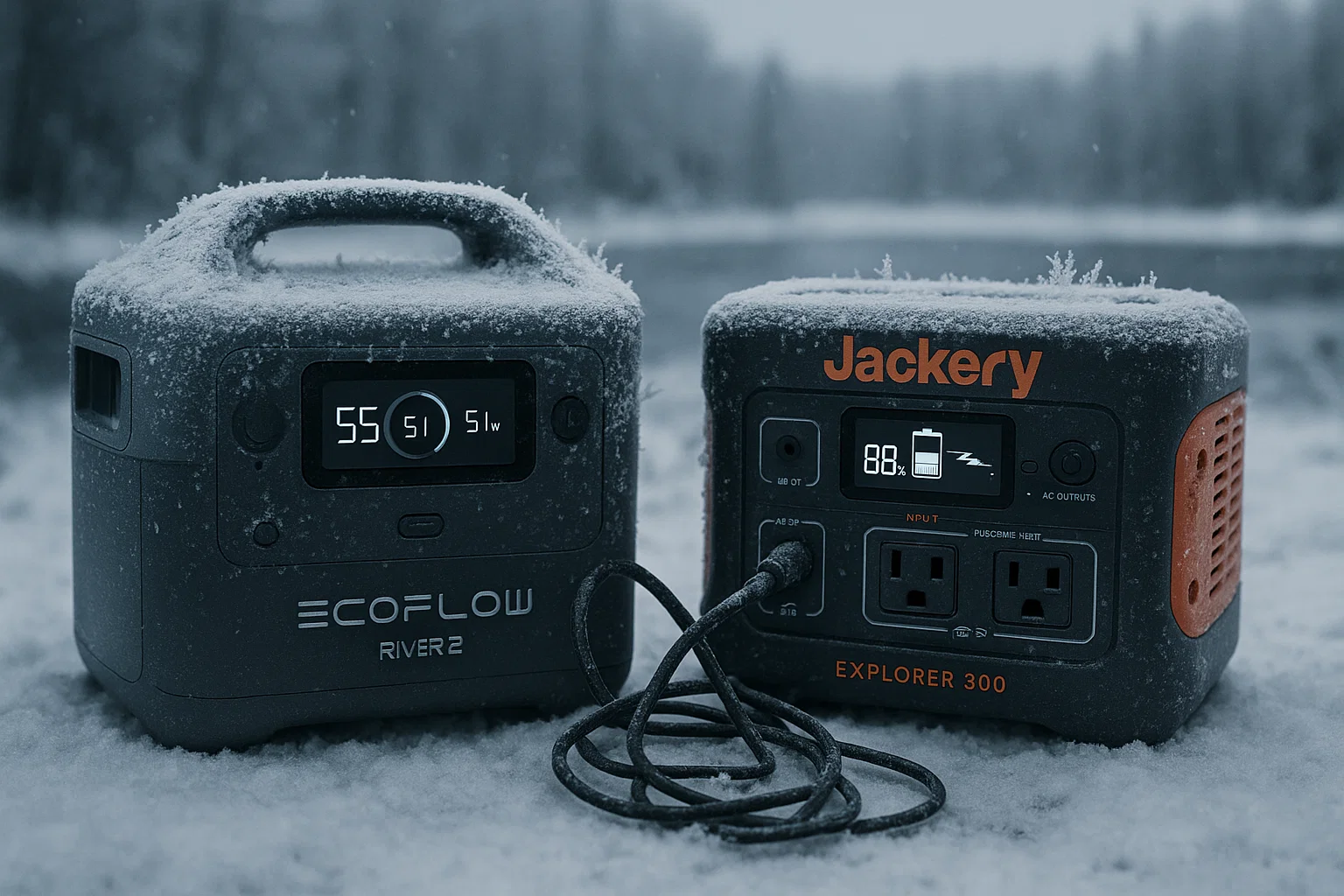
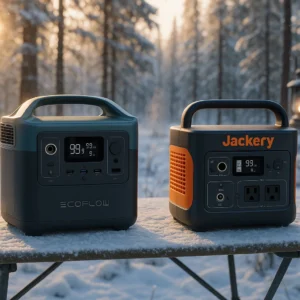
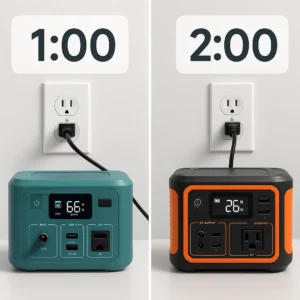

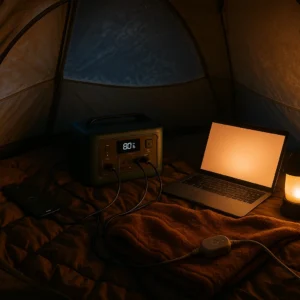
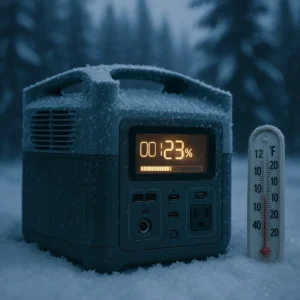


Leave a Reply